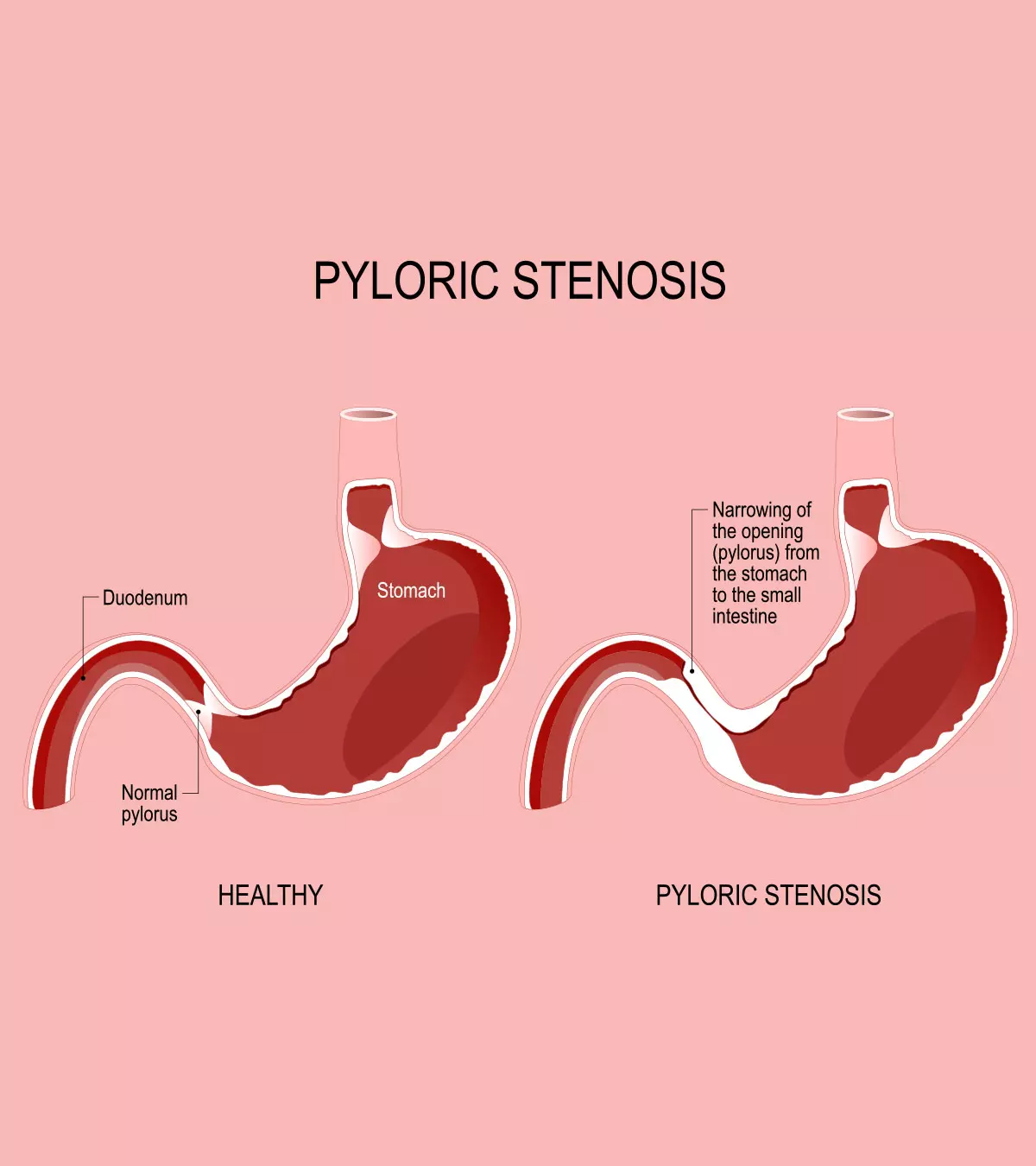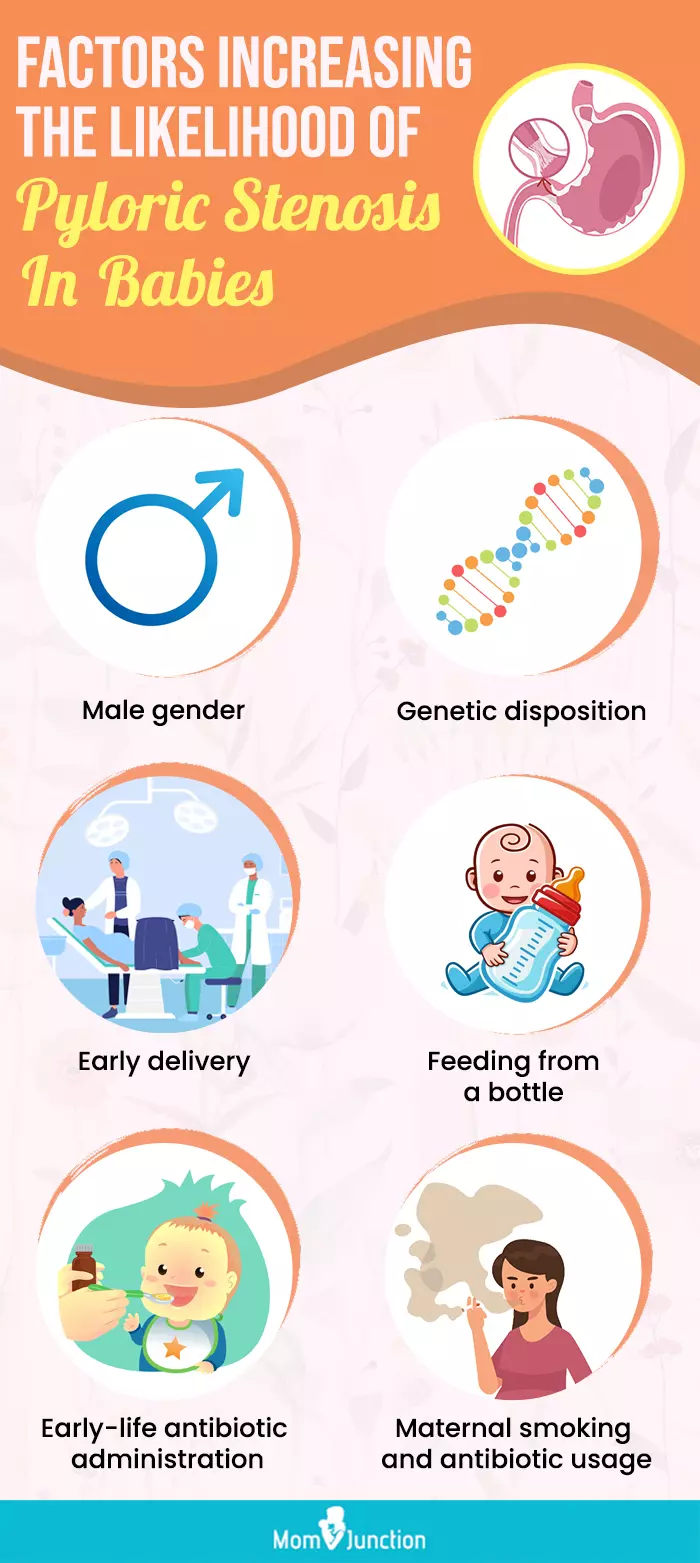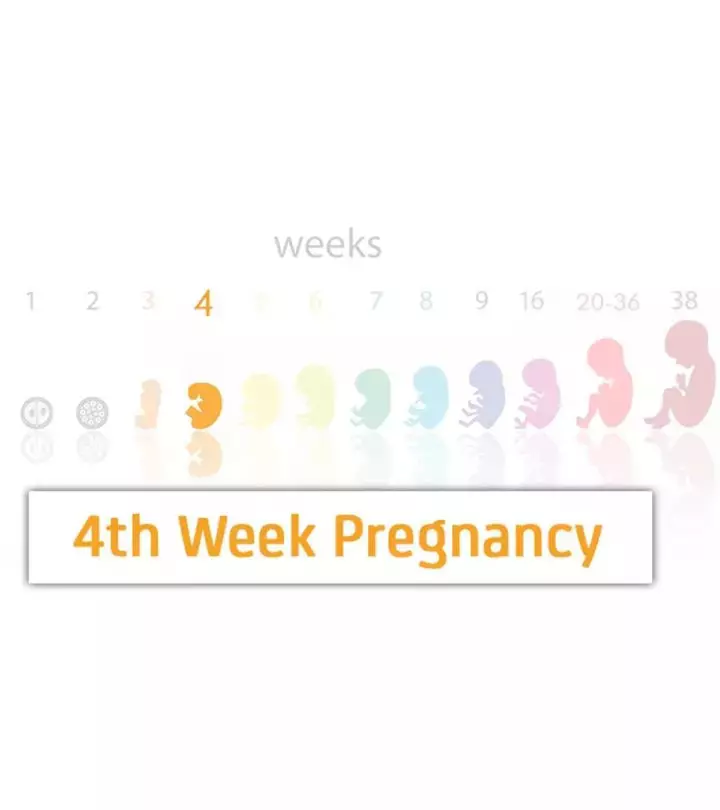
Image: Shutterstock
The narrowing of the pylorus (opening from the stomach into the duodenum) is called pyloric stenosis. Pyloric stenosis in babies occurs due to the thickening of the pylorus muscles, preventing the food from passing through the stomach to the intestines. According to StatPearls Publishing by the National Library of Medicine, two to five in 1000 live births per year are diagnosed with pyloric stenosis. AD
This pediatric condition may cause vomiting after being fed, increasing the risk of fluid deficiency, nutrient deficiency, and weight loss. Babies with pyloric stenosis may seem hungry all the time, and vomiting may increase their food demand.
Keep reading this post to know about the symptoms, causes, risk factors, diagnosis, treatment, and complications of pyloric stenosis in babies.
Key Pointers
- Pyloric stenosis is a condition in babies, where the muscle between the stomach and small intestine (pylorus) thickens, preventing the passage of food.
- This condition leads to persistent vomitings, hunger, dehydration, and bowel changes in babies.
- It could further lead to complications such as jaundice, bleeding, irritation in the stomach, and developmental delays.
- Pyloric stenosis can be fixed by surgery.
Signs And Symptoms Of Pyloric Stenosis
You may notice pyloric stenosis signs and symptoms in your baby within three to five weeks after birth. The onset of pyloric stenosis is rare in infants older than three months.
 Quick fact
Quick factThe signs and symptoms of pyloric stenosis in babies include the following(1).
- Vomiting: Forceful vomiting that may go several feet across a room is seen after feeding. Some babies may have mild vomiting initially which gradually worsens to projectile vomiting. The vomitus consists of breastmilk or formula and rarely contains blood. You might experince feeding dififculties.
- Abdominal contractions: A wave-like movement on the upper abdomen may occur due to stomach contractions (peristalsis). This is usually seen after feeding but before vomiting. This is due to stomach muscles trying to move food through the narrow pylorus to the intestine.
- Hunger: Babies with pyloric stenosis may demand feeding soon after vomiting.
- Bowel habit changes: Babies may have constipation or fewer bowel movements since less food reaches the intestines.
- Dehydration: Vomiting in babies may result in dehydration. Dry diapers, fewer wet diapers, crying without tears, and lethargy are the notable signs of dehydration. You must seek immediate medical care in such cases.

Image: Shutterstock
- Poor weight gain: Babies with pyloric stenosis may have weight loss or poor weight gain due to inadequate absorption of nutrients and affect an infant’s health.
Seek medical care if your baby has signs and symptoms of pyloric stenosis. Delaying the care may increase the risk of dehydration and lead to nutritional deficiencies.
Causes And Risk Factors For Pyloric Stenosis

Image: Shutterstock
Pyloric stenosis, also referred to as gastric outlet obstruction, occurs due to the thickening of the pylorus, but the exact cause behind it is unknown (2). Genetic and environmental factors may be involved in the development of this anomaly. Environmental factors could play a significant role since pyloric stenosis may often not be present at birth and usually develops later.
 Research finds
Research findsThe following factors may increase the risk for pyloric stenosis in some babies (2).
- Male gender
- Positive family history
- Premature birth
- Bottle-feeding
- Antibiotics use, such as erythromycin, in early life
- Maternal smoking and certain antibiotics use during pregnancy
It is not entirely known how these factors increase the risk of pyloric stenosis. Some babies with risk factors may not develop this condition.
Diagnosis Of Pyloric Stenosis

Image: Shutterstock
Pediatricians may be able to palpate enlarged pylorus muscle as an olive-shaped palpable mass or lump on the abdomen. Doctors may also ask you to feed your baby and look for abdominal contractions and projectile vomiting.
The following tests are ordered if the symptoms and signs during physical examinations are suggestive of pyloric stenosis (3).
- Ultrasound could help visualize and examine the narrow pylorus.
- Abdominal X-ray (barium swallow or upper GI series) are taken to confirm the diagnosis further or if the ultrasound is not clear.
- Blood and other diagnostic tests are also conducted to evaluate dehydration and electrolyte balance that could indicate poor absorption of nutrients.
Pediatricians may refer your baby to a pediatric gastroenterologist or a surgeon to further diagnose and treat pyloric stenosis.
Treatment For Pyloric Stenosis

Image: Shutterstock
A surgical procedure called pyloromyotomy is required to treat pyloric stenosis. Thickened pylorus muscle is incised until the inner mucosal layer bulges out, letting the stomach contents pass to the intestines without issues. Pyloromyotomy can be done through traditional open surgery or laparoscopic surgery (4).
Intravenous fluid and electrolytes are given before surgery for dehydrated babies. Your baby may also need IV fluids for a few hours after surgery. Feeding sessions usually begin after 12 to 24 hours of surgery, and you may have to feed your baby more often to meet the nutritional needs. Some babies may have vomiting for a few days after surgery.
The improvement in medicine has led most surgeons to consider laparoscopic surgery as the standard procedure for treatment. David Fetterman, a father of two, shares how his son’s pyloric stenosis treatment came across as a less complex procedure than his own. “Nowadays, it is laparoscopic. They go in there without disturbing everything and make the cut. Today, the operation takes about an hour including prep and recovery. The little ones can eat the same day and go home the next. Little David (my son) was a textbook case. He ate already and tomorrow – home he goes.”
David Senior had the condition as an infant as well and reminisces how it was treated back then through open surgery. He says, “In my day, they pulled everything out a bit to work on it which created more stress on all the neighboring organs (i).”
If your little one has other complications, other procedures may be needed. Ask your child’s surgeon about the exact procedures to be done and the roadmap for the baby’s recovery.
Complications Of Pyloric Stenosis
The possible complications of pyloric stenosis may include the following (5).
- Dehydration and hypovolemic shock may occur due to fluid and electrolyte loss from persistent vomiting.
- Jaundice is seen in some babies due to reduced liver enzyme levels that itself may occur due to inadequate nutrition.
- Growth and development failure may be seen in some babies with nutritional deficiencies.
- Stomach irritation and bleeding due to repeated vomiting may occur in some cases.
Babies usually get well and grow after surgical intervention (6). Bleeding and infection may happen after surgery in some babies. You may discuss with your doctor the possible post surgery complications and requisite follow-up care.
Frequently Asked Questions
1. Do babies still poop with pyloric stenosis?
Babies with pyloric stenosis do pass stools but less frequently. It is because the food does not adequately reach the intestine, and mucus may also be present in stools (1) (7).
2. Is pyloric stenosis painful in infants?
Pyloric stenosis is responsible for a baby’s stomach pain and could be accompanied by other associated symptoms (8). Constant baby care is required to soothe your little one.
3. Is pyloric stenosis an emergency?
Pyloric stenosis is an urgent condition that needs immediate treatment. Surgical correction along with medical treatment is often advised after diagnosis of the disorder (9)
4. Is pyloric stenosis a congenital disability?
Pyloric stenosis is a congenital disability that is a condition present from birth. This disorder may run in some families but may be multifactorial. It involves both genetic and environmental factors (2).
5. How can parents prevent pyloric stenosis in their babies?
It is impossible to hinder the onset of pyloric stenosis. However, if there is a familial history of this condition, it is recommended that the healthcare provider be informed. It will allow the provider to be vigilant for any potential manifestations of pyloric stenosis. Familiarizing oneself with the indications of pyloric stenosis can lead to expedited assistance. Moreover, early treatment can help prevent pyloric stenosis-associated complications, such as weight loss, dehydration, and malnourishment (12).
6. What is the best way to monitor a baby with pyloric stenosis?
Follow basic rules for dealing with sickness in babies at home. First, watch for signs of dehydration. If the baby is slightly dehydrated, doctors might not need to intervene immediately, but it is crucial to monitor their condition to help prevent it from worsening. Unless the baby has other severe signs of illness, such as nausea and vomiting, they can stay home and be cared for while their symptoms are monitored (13).
7. Do babies with pyloric stenosis vomit after every feeding?
Babies with pyloric stenosis may vomit after every feed or after some feeds (12). According to experts, babies aren’t born with pyloric stenosis. Instead, the pylorus muscles thicken in the weeks after birth. As the muscle thickens, babies may have worsening vomiting almost after each feeding, along with additional symptoms like irritability and abdominal pain (4).
8. What are the long-term effects of pyloric stenosis treatment?
There are no known long-term effects of pyloric stenosis treatments, especially if the child has had a surgical intervention (12). However, the surgery may have short-term risks, such as post-surgical bleeding and anesthesia-related side effects (14).
9. How can parents support their child during recovery?
Parents should keep the surgical incision clean and dry and avoid using lotions or creams. Check infection signs such as redness, swelling, or fever. Ensure the child takes their prescribed medications on time. Babies may also be advised to consume clear liquids within 24 hours of surgery. Parents must also take them to follow-up appointments to monitor recovery (14).
Pyloric stenosis in babies may be a life-threatening condition since it leads to nutritional and fluid deficiencies. It is believed to be caused by environmental and genetic factors. Some typical pyloric stenosis symptoms in babies may include forceful vomiting, excessive hunger, and dehydration. If your baby shows these symptoms, consult a doctor without delay. An abdominal X-ray and blood tests will allow doctors to diagnose the condition. Pyloric stenosis can be successfully treated by a surgical procedure. Babies can usually lead a normal life after the treatment.
Infographic: Potential Risk Factors For Pyloric Stenosis
Pyloric stenosis is where the pylorus, the passage connecting the stomach and small intestine, becomes narrow. Although the exact cause is still uncertain, several known risk factors exist. This infographic explores the vital factors that might play a role in the development of this prevalent digestive disorder.

Illustration: Momjunction Design Team
Illustration: Pyloric Stenosis In Babies: Symptoms Causes And Treatment

Image: Stable Diffusion/MomJunction Design Team
Explore the delicate topic of pyloric stenosis in infants – a condition affecting their digestive system. Uncover the causes, symptoms, and insights into this common but often misunderstood concern through this video.
Personal Experience: Source
MomJunction articles include first-hand experiences to provide you with better insights through real-life narratives. Here are the sources of personal accounts referenced in this article.
i. Like father, like son – Pyloric stenosis.https://babyfetterman.blogspot.com/2006/12/like-father-like-son-pyloric-stenosis.html
References
1. Pyloric Stenosis; Nationwide Children’s Hospital
2. Pyloric Stenosis; University of Rochester Medical Center (URMC)
3. Pyloric Stenosis in Infants; MedlinePlus; US National Library of Medicine
4. Hypertrophic Pyloric Stenosis (HPS)- Help for Babies with Forceful Vomiting; Healthy children; The American Academy of Pediatrics
5. Pyloric Stenosis; St. Clair Hospital
6. Pyloric Stenosis; Children’s Hospital of Philadelphia
7. Pyloric Stenosis; KidsHealth
8. Pyloric Stenosis; Johns Hopkins Medicine
9. Pyloric Stenosis; Inova Children’s Hospital
10. Pyloric Stenosis; Indiana State Department of Health.
11. Roberto Galea, Edith Said; (2018); Infantile Hypertrophic Pyloric Stenosis: An Epidemiological Review; NCBI.
12. Pyloric Stenosis (HPS): Symptoms, Treatment & Tests; Cleveland Clinic
13. Patient education: Nausea and vomiting in infants and children (Beyond the Basics); UpToDate
14. Pyloric Stenosis; The Paediatric Society of New Zealand and Starship Foundation
Community Experiences
Join the conversation and become a part of our nurturing community! Share your stories, experiences, and insights to connect with fellow parents.
Read full bio of Dr. Dur Afshar Agha
Read full bio of Dr Bisny T. Joseph
Read full bio of Rohit Garoo
Read full bio of Shinta Liz Sunny





















